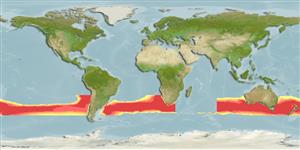Common names from other countries
>
Zeiformes (Dories) >
Oreosomatidae (Oreos) > Oreosomatinae
Etymology: Neocyttus: Greek, neos = new + Greek, kyttaros, kytos = a convex cavity.
Environment: milieu / climate zone / depth range / distribution range
Ecologie
marien bathypelagisch; oceanodroom (Ref. 51243); diepte 200 - 1240 m (Ref. 6390), usually 450 - 800 m (Ref. 30191). Deep-water; 23°S - 48°S, 81°W - 176°W
Southeast Atlantic: off Walvis Bay, Namibia to Cape Province, South Africa. Southwest Atlantic: off Argentina. Eastern Indian Ocean: southern Australia, from about 26°S in Western Australia to Broken Bay (Ref. 7300), New South Wales. Southwest Pacific: New Zealand.
Lengte bij maturiteit / Grootte / Gewicht / Leeftijd
Maturity: Lm 34.0, range 29 - ? cm
Max length : 40.0 cm SL mannelijk / geslacht onbekend; (Ref. 30191); max. gepubliceerd gewicht: 2.0 kg (Ref. 6390); max. gerapporteerde leeftijd: 100 Jaren (Ref. 27140)
Dorsale stekels (totaal) : 7; Dorsale zachte stralen (totaal) : 33 - 35; Anale stekels: 3 - 4; Anale zachte stralen: 30 - 33. Body grey, fins dark (Ref. 6548).
Inhabit continental slopes (Ref. 9563), forming large shoals over rough ground near pinnacles and canyons (Ref. 6390). Juveniles are pelagic and tend to be dispersed over smooth grounds (Ref. 6390). Feed on salps, fish, crustaceans and squid (Ref. 27230). Eggs float near the surface and larvae also inhabit surface waters (Ref. 6390).
Levenscyclus en paargedrag
Maturities | Voortplanting | Spawnings | Egg(s) | Fecundities | Larven
Displays seasonally synchronised reproduction.
Karrer, C., 1990. Oreosomatidae. p. 637-640. In J.C. Quero, J.C. Hureau, C. Karrer, A. Post and L. Saldanha (eds.) Check-list of the fishes of the eastern tropical Atlantic (CLOFETA). JNICT, Lisbon; SEI, Paris; and UNESCO, Paris. Vol. 2. (Ref. 6545)
Status op de Rode Lijst van het IUCN (Ref. 130435)
CITES (Ref. 128078)
Not Evaluated
Gevaar voor de mens
Harmless
Gebruik door de mens
Visserij: van minder commercieel belang
Tools
Speciale rapporten
Download XML
Internetbronnen
Estimates based on models
Preferred temperature (Ref.
115969): 5 - 9.7, mean 7.8 (based on 131 cells).
Fylogenetische diversiteitsindex (Ref.
82804): PD
50 = 0.5635 [Uniqueness, from 0.5 = low to 2.0 = high].
Bayesian length-weight: a=0.01698 (0.00988 - 0.02919), b=3.01 (2.85 - 3.17), in cm Total Length, based on LWR estimates for this species & (Sub)family-body (Ref.
93245).
Trofisch niveau (Ref.
69278): 3.6 ±0.53 se; based on food items.
Weerstandsvermogen (Ref.
120179): Zeer laag, minimale populatieverdubbelingstijd meer dan 14 jaar (tmax=100).
Fishing Vulnerability (Ref.
59153): High to very high vulnerability (70 of 100).
Climate Vulnerability (Ref.
125649): Moderate vulnerability (41 of 100).
